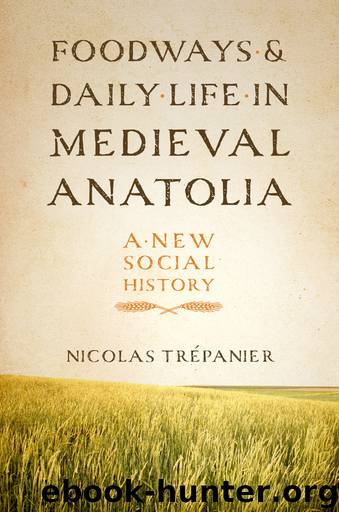Foodways and Daily Life in Medieval Anatolia by Nicolas Trépanier

Author:Nicolas Trépanier [TréPanier, Nicolas]
Language: eng
Format: epub
Publisher: University of Texas Press
Published: 2014-12-08T16:00:00+00:00
(APPENDIX)
Sources
The primary sources I have used include the bulk of the original narrative material produced in fourteenth-century Anatolia. During the first part of my research, I combed through each one of them in order to identify the relevant passages. As will be seen below, the nature, frequency, and importance of such passages vary widely from one literary genre to another and from one source to the next. The narrative sources I have used fall into three broad categories: hagiographies and other religious texts, chronicles and epics, and travelogues and other texts. To this, one should add two more groups of sources: approximately forty endowment deeds (waqfiyyas), closer in form to archival documents than to narrative texts, as well as a significant body of archaeological reports.
HAGIOGRAPHIES AND RELIGIOUS TEXTS
While diversity may be the master word as far as the source material for this study is concerned, religious texts and especially hagiographies were no doubt the single most important type of source for my purposes. That this type of source contains a higher concentration of relevant data per page is due to many factors, particularly the format in which they are written.
Unlike modern biographies, where the general narrative gives way to specific scenes and dialogue only to illustrate a given event or personality trait in greater detail, hagiographies composed in medieval Anatolia are essentially collections of anecdotes, mostly centered on the performance of miracles or other pious deeds by a Muslim saintly figure. Because these anecdotes are used as arguments to demonstrate the sanctity of the main character (rather than as the building blocks in a general depiction of his life), they are often presented in a loose chronological order and framed by few if any generalizing narrative statements (such as “he lived there for the next five years” or “he had a good relationship with his neighbors”). These comments apply to a variable degree to the various hagiographies, but most are best described as argumentative texts seeking to prove a master’s sainthood, rather than descriptive ones giving an account of his life. This anecdotal structure makes hagiographies immensely useful for my purposes, because they impose the presence of “trivial” elements in the text: a philosopher can explain an Aristotelian principle in “the sublunary world,” but a saint who miraculously makes fruits grow in the middle of the winter has to do so in an orchard.
It is, of course, a general characteristic of medieval literature to provide little if any descriptions, and anybody hoping to find Flaubertian flourishes about the landscape visible from the kitchen window or the texture of a character’s skin in the Manaqib al-ʿArifin is bound to be disappointed. Yet the harvest is quite rich if one measures it by medieval standards. Because hagiographies have to mention some narrative “props” to allow their main character to perform miracles, and because the primary objective of the text is to convey the miracle as a believable event, these “props” have to appear realistic to the intended audience, people often living in the same or similar settings as the actors of the anecdotes, and only shortly afterward.
Download
This site does not store any files on its server. We only index and link to content provided by other sites. Please contact the content providers to delete copyright contents if any and email us, we'll remove relevant links or contents immediately.
| Africa | Americas |
| Arctic & Antarctica | Asia |
| Australia & Oceania | Europe |
| Middle East | Russia |
| United States | World |
| Ancient Civilizations | Military |
| Historical Study & Educational Resources |
Empire of the Sikhs by Patwant Singh(22765)
The Wind in My Hair by Masih Alinejad(4841)
The Templars by Dan Jones(4558)
Rise and Kill First by Ronen Bergman(4545)
The Rape of Nanking by Iris Chang(4022)
12 Strong by Doug Stanton(3419)
Blood and Sand by Alex Von Tunzelmann(3055)
The History of Jihad: From Muhammad to ISIS by Spencer Robert(2504)
Babylon's Ark by Lawrence Anthony(2430)
The Turkish Psychedelic Explosion by Daniel Spicer(2245)
No Room for Small Dreams by Shimon Peres(2235)
Gideon's Spies: The Secret History of the Mossad by Gordon Thomas(2234)
Inside the Middle East by Avi Melamed(2230)
Arabs by Eugene Rogan(2193)
The First Muslim The Story of Muhammad by Lesley Hazleton(2154)
Bus on Jaffa Road by Mike Kelly(2035)
Come, Tell Me How You Live by Mallowan Agatha Christie(2025)
Kabul 1841-42: Battle Story by Edmund Yorke(1921)
1453 by Roger Crowley(1880)
